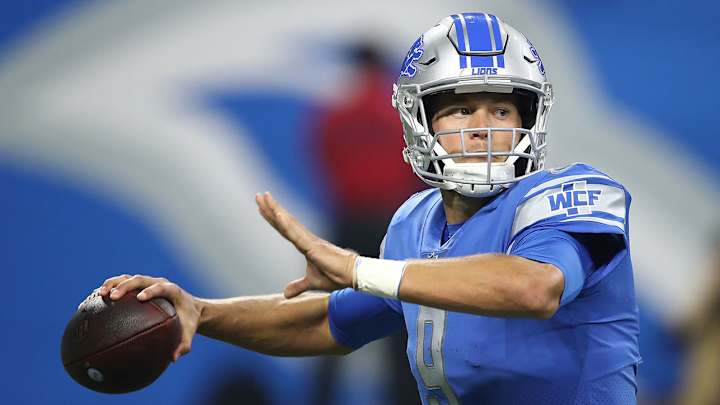Matt Patricia Takes Over a Balanced Team With Playoff Hopes. 10 Thoughts on the Detroit Lions

With the NFL season just a couple weeks away, Andy Benoit is previewing every NFL team in reverse order of last season’s finish. Up today: the Detroit Lions, who finished 9–7 in 2017.
1. With Matthew Stafford—the most gifted thrower not named Aaron Rodgers—in the heart of his prime, it’s time for the Lions to feature a more aggressive passing attack. Receivers Marvin Jones and Kenny Golladay (a looming breakout star entering Year Two) can both win on contested balls downfield. Leveraging that with darting underneath weapon Golden Tate is offensive coordinator Jim Bob Cooter’s mission. Yes, Stafford was turnover-prone in downfield-attacking systems early in his career, but his field-reading and decision-making have matured greatly under Cooter.
If a play-caller doesn’t believe his offense can run for five-plus yards on 2nd-and-10, he could be reluctant to throw aggressively on 1st-and-10. This might have factored with Cooter last season; Detroit’s anemic ground game ranked dead last in yards per attempt. The Lions tried to supplement it with more receiver screens, but that’s not the same. (The Dolphins learned this the hard way, too.) And so GM Bob Quinn spent his first-round pick on Arkansas road-grading guard Frank Ragnow and his second-rounder on Auburn tailback Kerryon Johnson. With a system that affords Stafford great freedom for checking in and out of runs at the line of scrimmage, the pieces—on paper—are in place for a rejuvenated rushing attack.
2. If Ragnow pans out at left guard, the Lions will have a top-five offensive line. Left tackle Taylor Decker has smooth feet and firm foundational strength. Center Graham Glasgow occasionally shined as a second-level run-blocker late last year. T.J. Lang is a rock at right guard, while Rick Wagner is one of the few right tackles who doesn’t need consistent help in pass protection. Last season these linemen were rarely healthy at the same time. The downside of that is Stafford was sacked a career-high 47 times. The upside is it gives the Lions more experienced O-line depth entering this season.
10 Thoughts on the 2018 Chicago Bears, Who Should Be Better on Both Sides of the Ball
3. Stafford has 20 fourth quarter comebacks over the last four years. One reason why is his rocket arm creates additional throwing opportunities in the outer voids of Cover 2—the coverage defenses most commonly play when protecting a lead.
4. Theo Riddick remains one of the three or four best pass-catching backs in football, especially on angle and option routes. He poses significant problems for defenses out of three-receiver sets because so often the play design naturally relates his route to Golden Tate’s. That’s an imposing combination of underneath speed and shiftiness, especially to a zone defense, which relies on linebackers there.
5. With Eric Ebron gone, the Lions are less talented at tight end, but they won’t be less effective. Newly acquired Luke Willson proved in Seattle he can capitalize when the play design wins.
6. Matt Patricia’s New England secondary had a lot of versatile cover artists, which he used to mix and match assignments, particularly in man-to-man. He can do the same in Detroit. Corners Teez Tabor, Nevin Lawson and DeShawn Shead have experience playing outside and in the slot. Projected slot starter Quandre Diggs—maybe The Best Player Nobody Talks About—flourished as a fast, hard-hitting fill-in safety when Tavon Wilson was injured last November. Speaking of Wilson, he played multiple positions, including linebacker, as a Patriot from 2012-15. In Detroit, he’s been more of a traditional safety because Miles Killebrew has admirably handled the dime ‘backer duties. Starting alongside Wilson has been Glover Quin, who was a terrific box and matchup safety as a Texan (2009-12) and is now an even more terrific half-field and high-hole defender. Besides Minnesota’s Harrison Smith, Quin is football’s best openfield tackling defensive back.
7. Patricia also has a true No. 1 corner to build around in Darius Slay. The former second-round pick has improved in each of his five NFL seasons and can now travel outside in both man and zone against most receivers, including quicker ones.
Matt Patricia Is Working to Change the Lions' Culture
8. Second-year linebacker Jarrad Davis has uncanny physical talent. He’s thick and limber, and there’s a glide to his movement, almost as if he’s playing on skates. If Davis can become more comfortable in coverage (struggles there got him benched for fourth-round rookie Jalen Reeves-Maybin in certain nickel situations late last season) he’ll be one of the NFL’s premier players.
9. It appears Patricia will emphasize gap-plugging run D principles just like in New England. The Lions awarded a three-year, $17.25 million contract to free agent Devon Kennard, a consummate edge-setter who can play the Rob Ninkovich role. They also invested $3.5 million in Sylvester Williams, a wide but fleet-footed sixth-year nose tackle. The X-factor will be third-year defensive tackle A’Shawn Robinson. He’s perfectly built for the scheme and capable of explosive plays, but that must be displayed on a more regular basis.
10. It’s no surprise defensive end Ziggy Ansah was franchise-tagged. Besides being injury prone the past few years, Ansah’s film doesn’t match his statistical output. In 2016 he had just two sacks but stood out every week as an edge rusher and inside-looping stunt artist. In 2017, he happened to have 12 sacks but barely made ripples on most snaps. His playing time even dropped down the stretch. The Lions need The Good Ansah to emerge. Anthony Zettel and Kerry Hyder flash from time to time, but neither is a premiere pass rusher.
BOTTOM LINE: If Detroit’s ground game develops, this suddenly becomes one of the most balanced teams in football. Wild Card expectations would be fair.
• Question or comment? Email us at talkback@themmqb.com.
